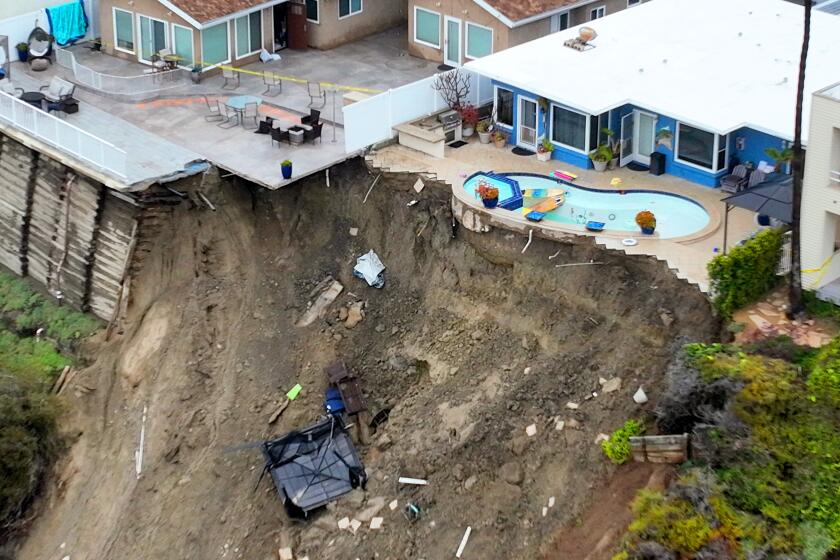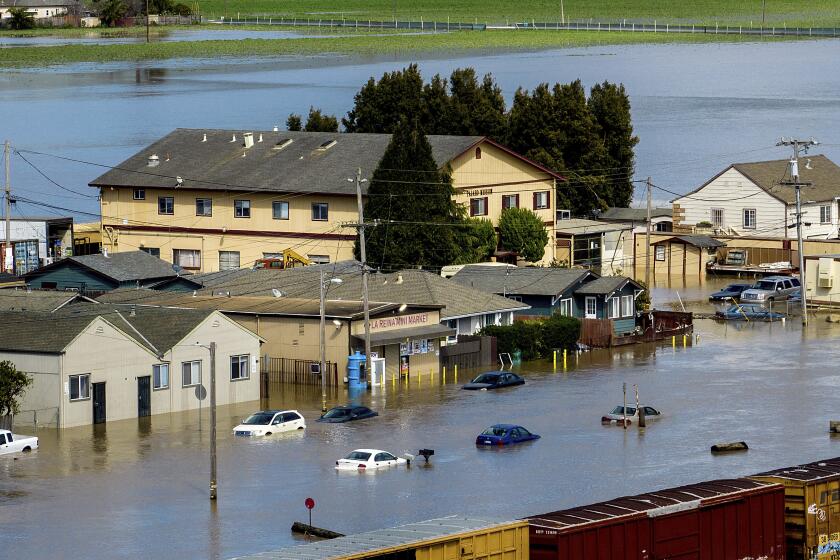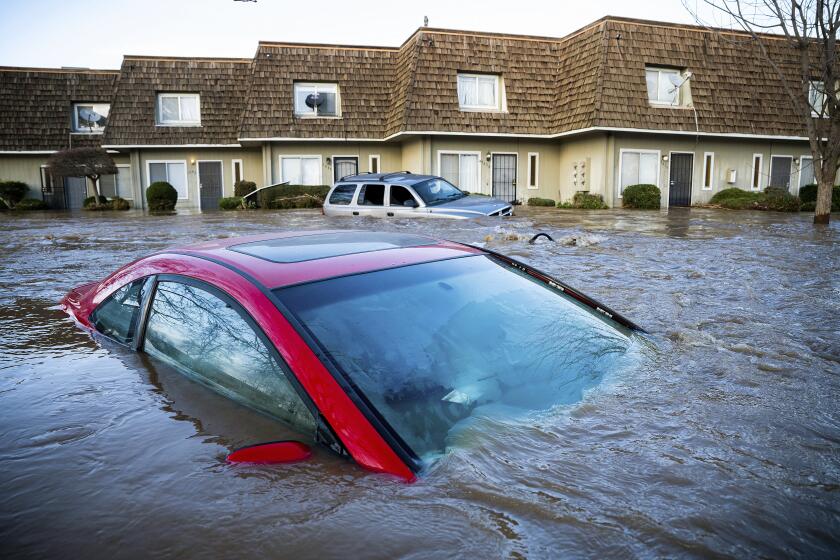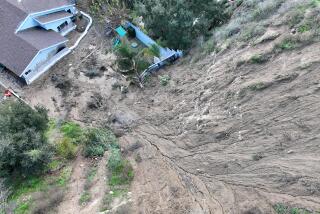California deals with surging rivers, sliding rocks and flooded towns as storm passes
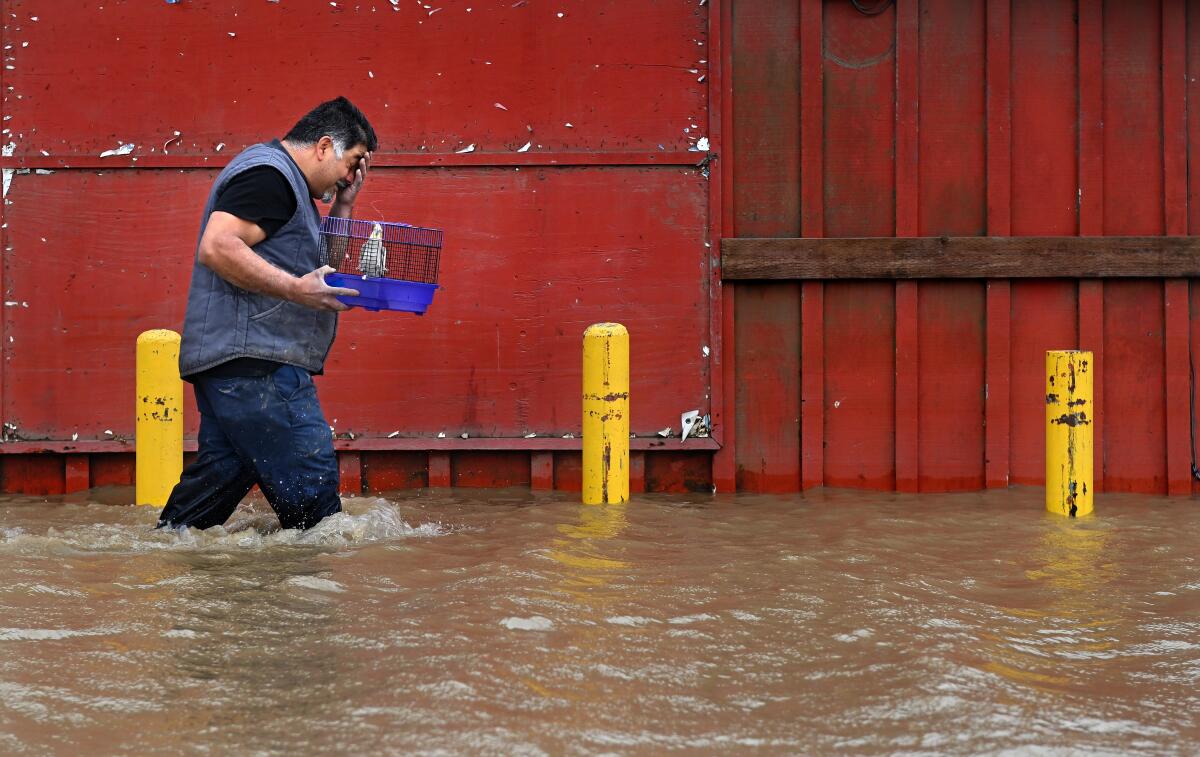
PAJARO, Calif. — Surging rivers. Sliding rocks. Flooded towns.
The 11th atmospheric river storm of the season left a trail of soggy misery in California as it broke decades-old rainfall records and breached levees this week.
In the Tulare County city of Porterville, residents on both sides of the Tule River were ordered to evacuate Wednesday morning as levels rose at Lake Success, sending water running over the spillway at Schafer Dam.
“Right now the dam is in good working order — there’s no threat to the structure of the dam — but we have significant water coming off of the spillway,” said Carrie Monteiro, a spokeswoman for the Tulare County Emergency Operations Center.
California continues to deal with damage from March storms: surging rivers, mudslides, breached levees and displacement in flooded towns.
Lake Success saw a significant increase in inflows overnight, peaking at nearly 19,800 cubic feet of water rushing in per second Wednesday morning, according to state data. Visalia and Porterville have declared a state of emergency.
The increased flow from the spillway is adding more water to the river and tributaries below, both of which are already full from the last storm, Monteiro said, adding that there is “flood concern.”
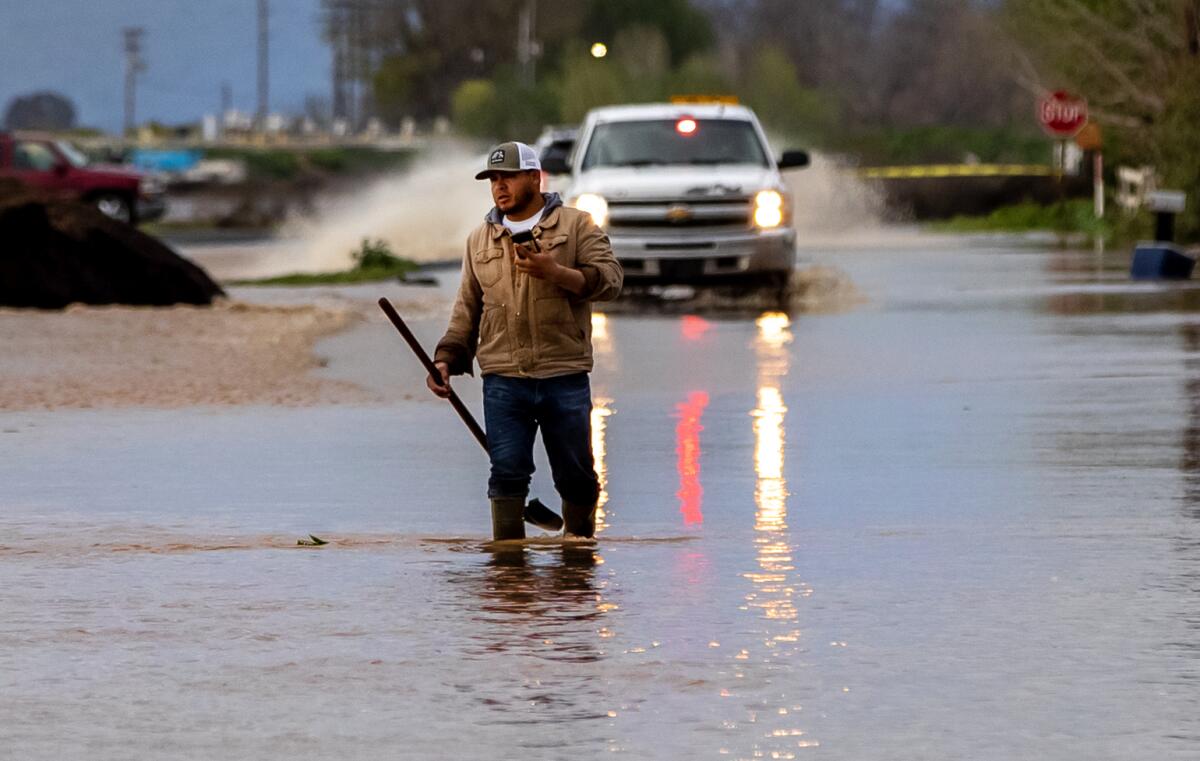
Water was about six inches from the bottom of one of the bridges on the Tule River; nearby, bulldozers were clearing debris and piling dirt mounds in an effort to protect a neighborhood from potential flooding.
Johanna Morales, 32, was away Wednesday morning when the Tule River breached and flooded her home.
Her landlord called around 11 a.m. with the news. Many of her valuables couldn’t be saved, she said: “It was too late.”
But on Wednesday evening, she and other family members came to salvage belongings. Morales waded through waist-high water holding plastic trash bags filled with her possessions. And when she stopped to consider what came next, she broke into tears. For now, she said, they were just saving what they could.
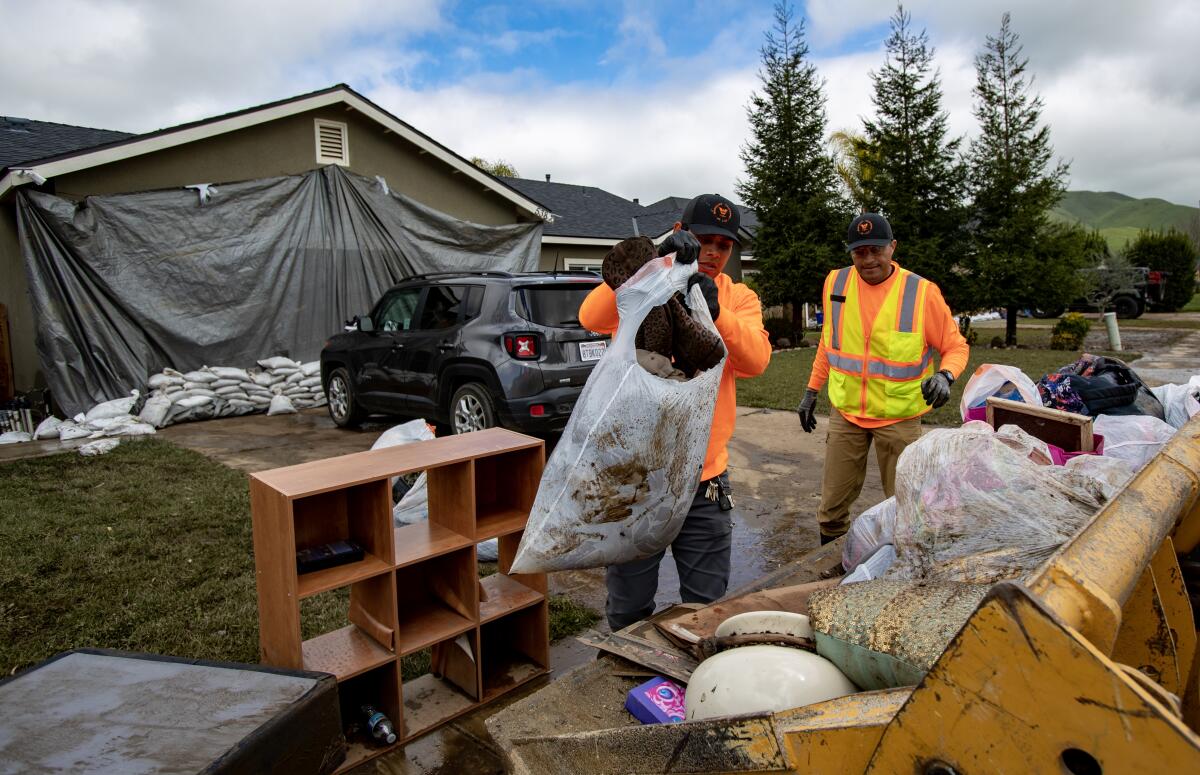
Gov. Gavin Newsom said the devastation across the state was indicative of extreme weather swings driven by climate change.
“You look back at the last few years in this state — it’s been fire to ice, and no warm bath in between,” he said during a news briefing Wednesday in Pajaro, the Monterey County town flooded by a levee breach last week. “If anyone has any doubt about Mother Nature and her fury — if anyone has any doubt about what this is all about in terms of what’s happening to the climate and the changes that we’re experiencing — come to the state of California.”
Storm clouds were beginning to clear Wednesday, though many effects are expected to linger.
The migrant town of Pajaro, Calif., was flooded last week during powerful storms that caused a levee to break. Now, another storm is moving in.
More than 150,000 people remained without power statewide, many in the San Francisco Bay Area, where classes were canceled at more than a dozen schools in Cupertino.
In San Clemente, four apartment buildings were evacuated after mud, rocks and debris tumbled down a hillside behind the buildings, the Orange County Fire Authority said. No injuries were reported, but the trail below the properties as well as a portion of Buena Vista along the shore were closed.
In the Los Angeles area, a debris flow in Baldwin Hills trapped several cars overnight. On Wednesday morning, as many as 30 vehicles were disabled by about five large potholes on the 71 Freeway near Pomona, according to the California Highway Patrol.
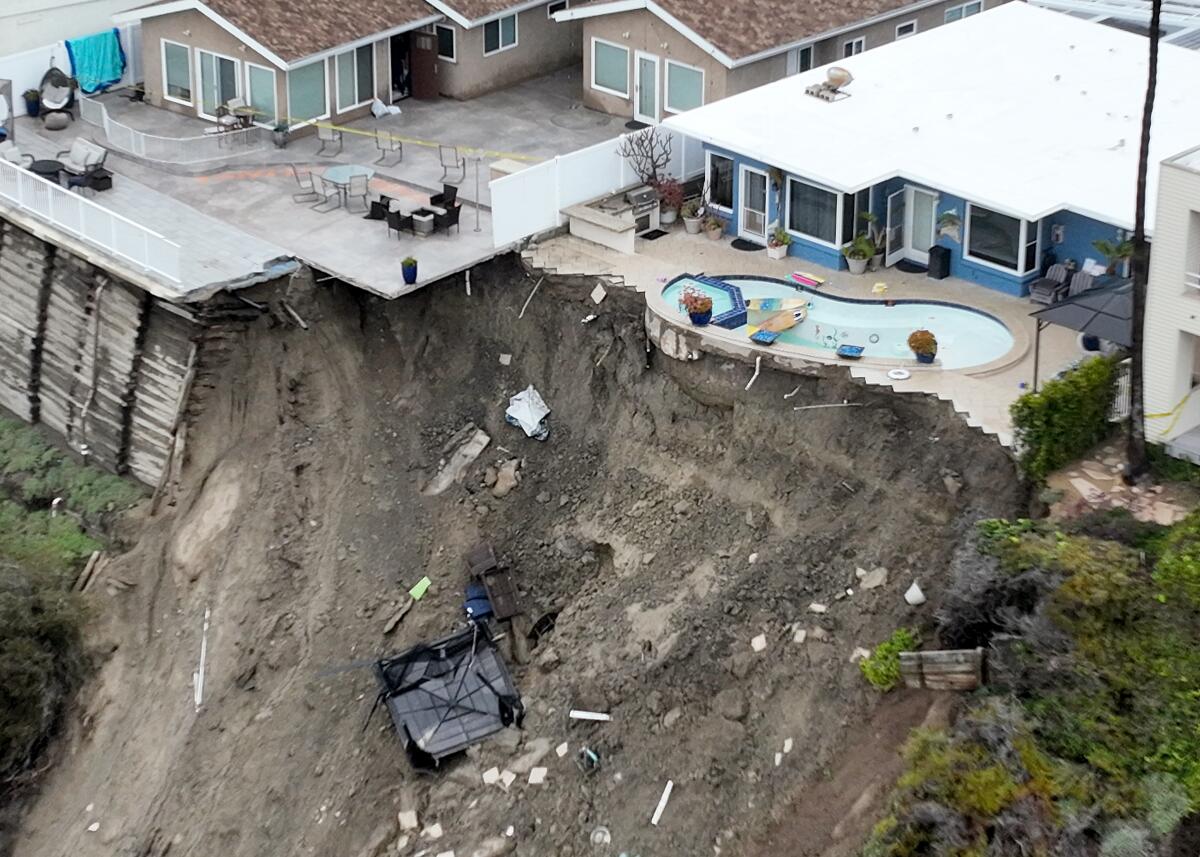
Multiple rainfall records for the date were set by large margins Tuesday, including 2.54 inches in Santa Barbara, breaking a record of 1.36 inches set in 1952, and 2.25 inches in Oxnard, beating 1930’s mark of 1.46 inches. Los Angeles International Airport saw 1.97 inches, smashing a record of 0.43 of an inch set in 1982.
In the San Bernardino Mountains, heavy rain melted dense snowpack and sent torrents of water rushing down streets. As much as 4.3 inches of rain fell on the mountain slopes during the last storm, according to the National Weather Service, but officials said there weren’t any major issues from the rains.
An incoming storm threatens to overflow the swollen Salinas River, imperiling the lives of farmworkers and crops and triggering evacuations.
In Sacramento, reports of surfers and kayakers on the surging American River prompted warnings from the county.
The Fresno Fire Department responded to an apartment complex where a very large tree had toppled onto the building, displacing at least five adults and five children, said spokesman Jonathan Lopez-Galvan.
Perhaps the most lasting effect of the storm will be in the flooded community of Pajaro. A levee breach on the Pajaro River late Friday sent floodwaters rushing into the migrant town of about 3,000 people, prompting widespread evacuations and cutting off potable water to the area. It is likely that some people will never be able to return to their homes, county spokesman Nicholas Pasculli said.
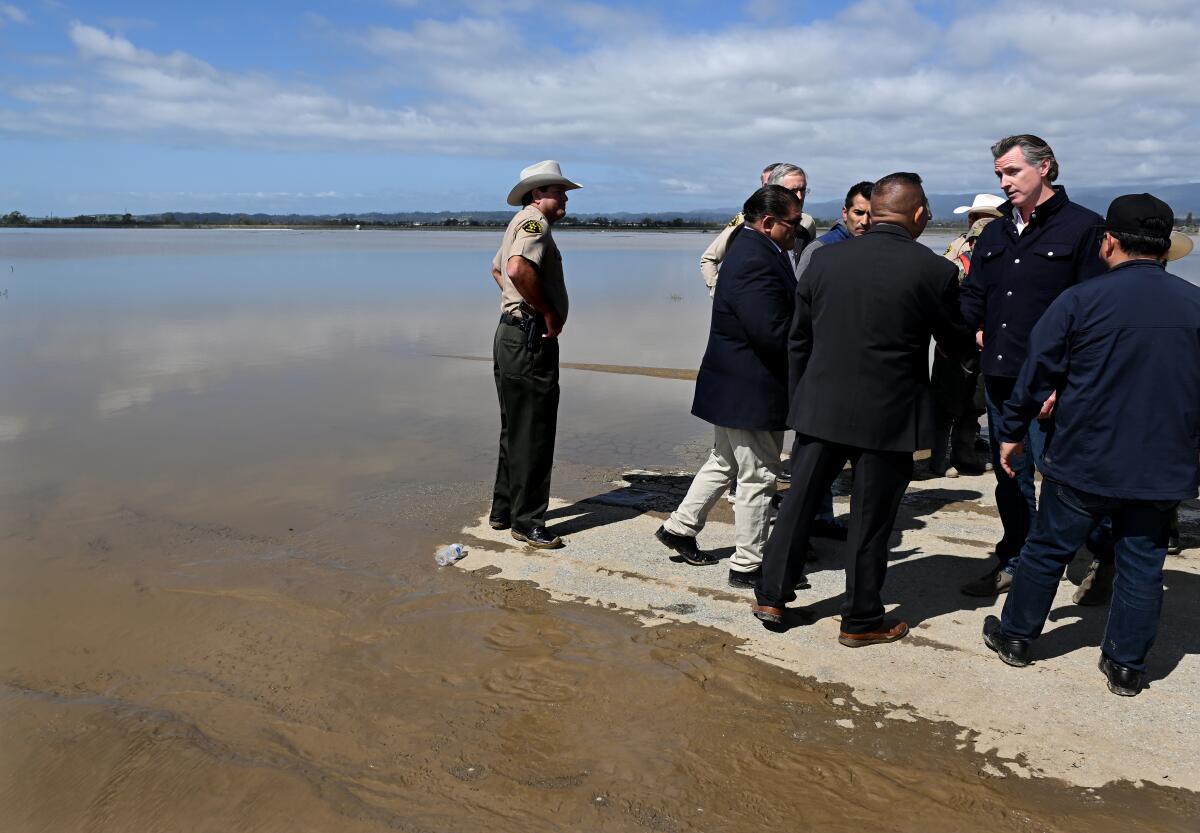
State and county officials were working to stabilize the breach, but there was no timeline for when it will be fixed.
Officials knew for decades that the levee was vulnerable to failure but never prioritized repairs because they believed it did not make financial sense to protect the low-income area, a Times report found this week.
On Wednesday, California Sen. Alex Padilla grilled Shalanda Young, director of the White House Office of Management and Budget, about the Army Corps of Engineers’ policy.
“We need to address how the Army Corps, as well as OMB, should be thinking beyond just the benefit-cost ratio in order to ensure we’re protecting vulnerable communities equitably,” Padilla said. “How can we shift the federal government’s approach to ensure that communities like Pajaro and Watsonville receive the resources they need before it’s too late?”
Young committed to working with Congress to ensure lasting changes “because there’s never enough money even with the infrastructure law,” she said.
A project to improve the Pajaro River levee system is anticipated to go to construction in 2024, and has so far received $67 million from President Biden’s $1.2-trillion infrastructure bill signed in 2021. That is the first in a series of federal investments.
The total project is expected to cost more than $400 million. Roughly 65% will be paid by the federal government, and the remainder by the state.
“Lots of communities have flood control projects that we can’t get to,” Young said. “But this idea that poor communities don’t deserve the same flood control protection as those with higher value and houses is just patently unfair.”
Speaking from Pajaro on Wednesday, Newsom said he was “committed to this community” and spoke critically of the fact that the levee — which has flooded several times since its construction in 1949 — wasn’t fixed decades ago.
In addition to federal funds, he said he has committed nearly $140 million in state funds to match project costs and help fix the levee. However, the process could take five to seven years to complete.
“We’ve got to change the way the federal government scores these projects to prioritize those communities that are most vulnerable, period, full stop,” he said.
He added that the United Way had secured $42 million from the U.S. Department of Agriculture to assist farmworkers affected by flooding in the region and will begin sending $600 checks immediately, regardless of recipients’ immigration status.
Residents forced from their homes in Merced by January’s storms battle the latest downpours and floods. They’re also battling break-ins.
Officials on Wednesday were also keeping a close eye on the nearby Salinas River, which remained swollen at the communities of Bradley and Spreckels on Wednesday morning.
Though the rains have mostly stopped, additional rises in the rivers are expected due to runoff, said Jeff Lorber, a meteorologist with the National Weather Service in the Bay Area. “It’s still very saturated, the soil, so moisture that’s pooled up in the mountains will take a while to filter down into the valleys.”
In Southern California, officials were similarly eyeing Conejo Creek in Camarillo, which peaked Wednesday morning and spurred a flood warning.
Officials in Santa Barbara County reported that the storm had created a waterfall in Tucker’s Grove Park, noting that the “flowing water will find its way to San Antonio Creek and eventually drain into the ocean.”
In Orange County, Supervisor Katrina Foley declared a local state of emergency on Tuesday to support storm responses in the area, prompted in part by a hillside collapse in Newport Beach that threatened some homes and sent a chunk of bluff tumbling down.
“My hope is that there is no further sliding on the shore, but if these three homes fall, a cascading effect may happen to the 50 other homes on the bluff and we must be prepared in case that happens,” Foley said in a statement.
The town has power and gas but no potable water. Gov. Gavin Newsom said farmworkers affected by the floods would receive checks of $600, regardless of immigration status.
Newsom expanded his state of emergency Tuesday night to include Orange, Alpine and Trinity counties, meaning 43 of California’s 58 counties are now covered by the declaration. More than 30 flood watches and warnings are in effect from the National Weather Service.
Forecasters said rain should taper in most areas by Wednesday afternoon. However, another atmospheric river is likely to hit the state next week.
For many Californians, relief can’t come soon enough. In flooded Pajaro, residents from nearby Watsonville joined a group of volunteers helping residents affected by the flood.
“I knew of one woman at a shelter that wanted a blanket for her grandson but she didn’t speak English and she didn’t speak Spanish really well,” said Jessica Sanchez, 34, who was helping hand out foam containers of chicken soup, pan dulce and atole, a hot Mexican drink.
“Some people have been wearing the same clothes for days now, they have no money and can’t afford to go to hotels,” Sanchez said.
Jose Aguirre, a farmworker, said he was unable to find space at a shelter and had to rent a hotel room. Paying $103 a day for a room he and his wife share with their 15-year-old daughter, he said he has enough money to stay for three days. He’s not sure what he’ll do next.
“We don’t have any work,” he said. “We all need help, some more than others.”
Vives reported from Pajaro, Rust from Menlo Park, Castleman from Porterville, and Smith from Los Angeles. Times staff writer Grace Toohey in Los Angeles contributed to this report.
More to Read
Sign up for Essential California
The most important California stories and recommendations in your inbox every morning.
You may occasionally receive promotional content from the Los Angeles Times.
